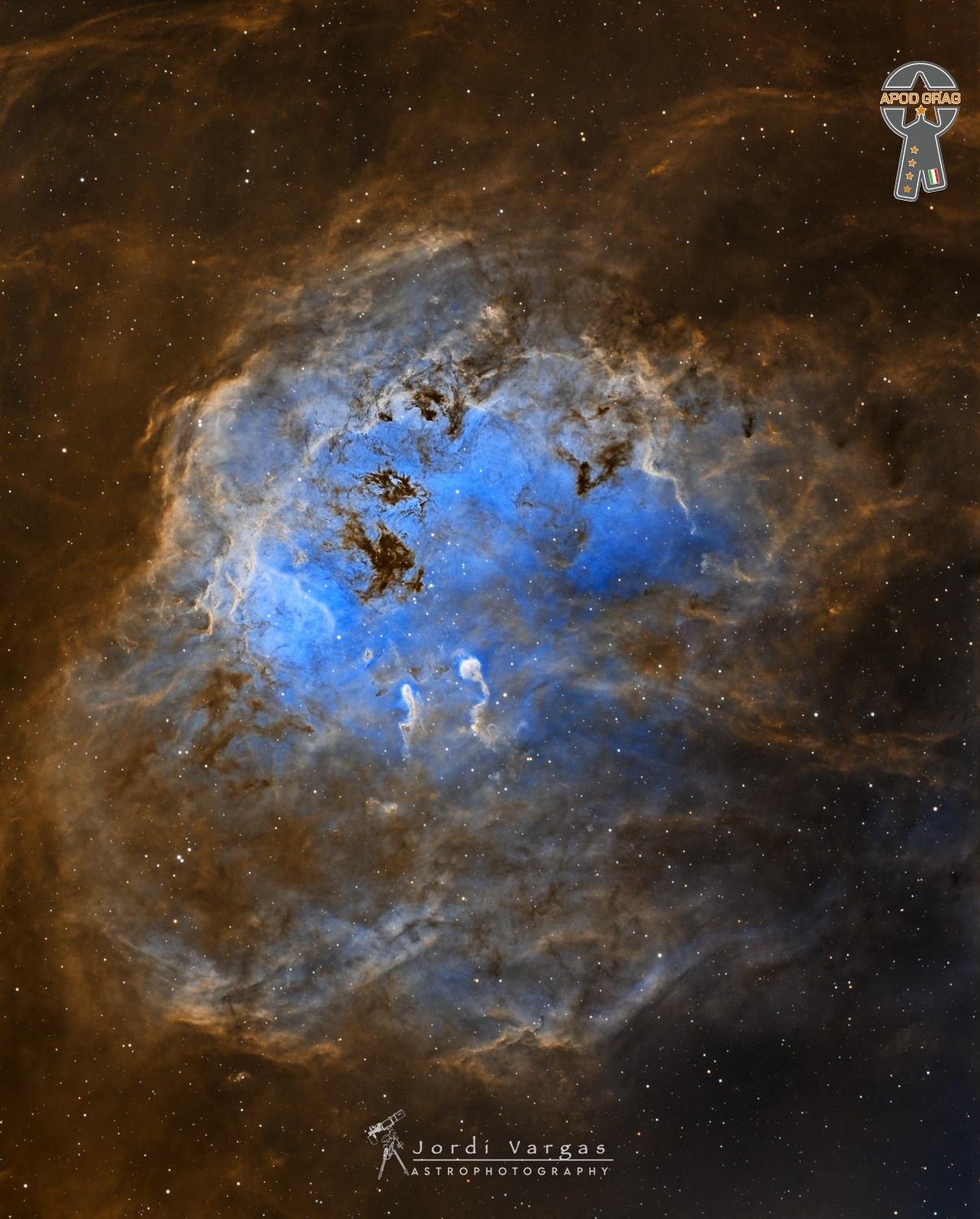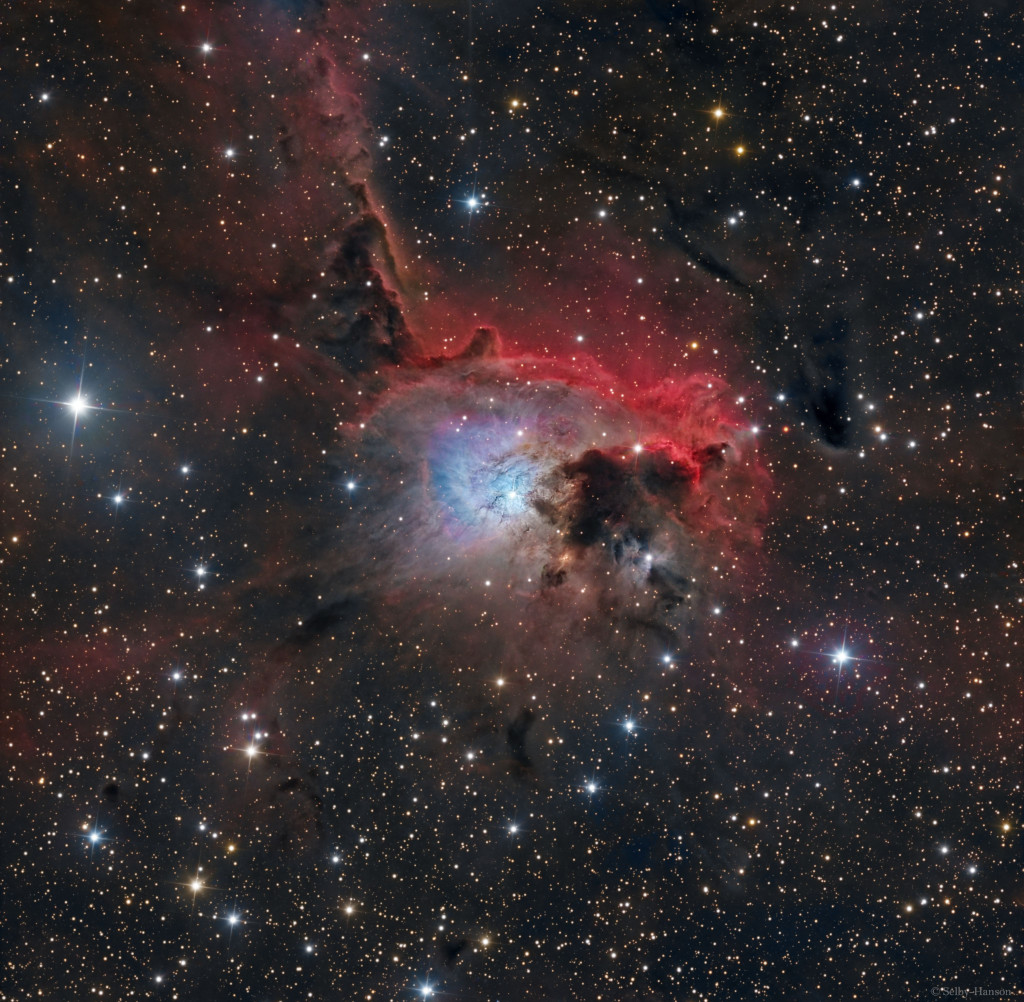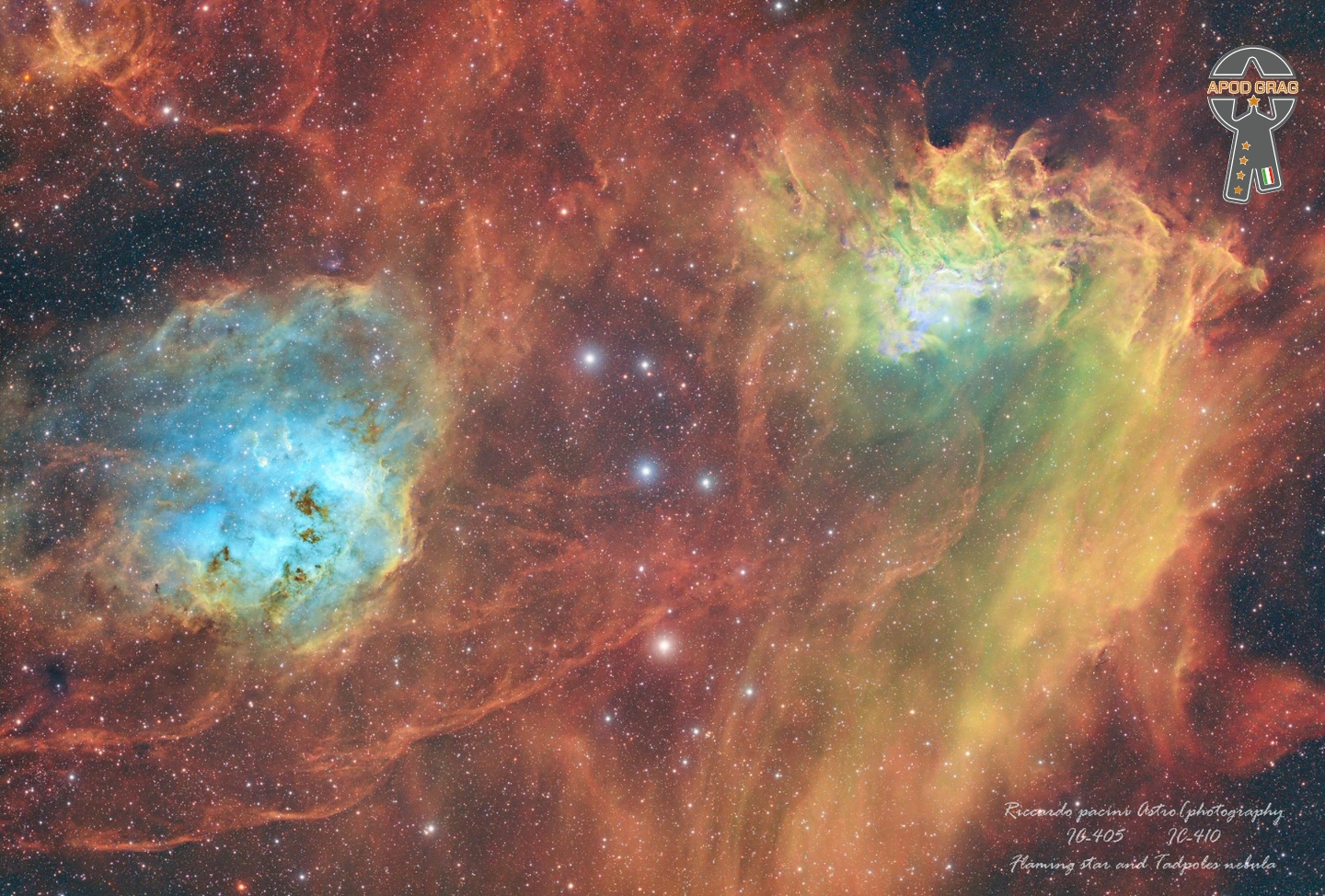Blog
In its third performance at the Gremlin Theater by Theatre 55 and its only matinee at 2pm on Sunday February 5th 2023. Remainder shows February 8th thru the 11th. Music with Shirley Mier, Jamie Carter, Lyra Olson and mick laBriola.

IC 410, sometimes known as the Tadpole Nebula because of its northeastern filaments, is a large emission nebula visible in the constellation Auriga; linked to it is the open cluster NGC 1893, formed by young, rather dispersed, massive stars. The region is home to important star formation processes generating massive stars.

more...
Al Kooper (born Alan Peter Kuperschmidt; February 5, 1944) is a retired American songwriter, record producer and musician, known for organizing Blood, Sweat & Tears, although he did not stay with the group long enough to share its popularity. Throughout much of the 1960s and 1970s he was a prolific studio musician, playing organ on the Bob Dylan song “Like a Rolling Stone“, French horn and piano on the Rolling Stones song “You Can’t Always Get What You Want“, and lead guitar on Rita Coolidge‘s “The Lady’s Not for Sale“, among many other appearances. Kooper also produced a number of one-off collaboration albums, such as the Super Session album that saw him work separately with guitarists Mike Bloomfield and Stephen Stills. In the 1970s Kooper was a successful manager and producer, recording Lynyrd Skynyrd‘s first three albums. He has also had a successful solo career, writing music for film soundtracks, and has lectured in musical composition.
Al Kooper was born in Brooklyn, New York City, to Sam and Natalie Kuperschmidt (who were Jewish),and grew up in Hollis Hills, Queens, New York.
more...Richard Quentin Laird (February 5, 1941 – July 4, 2021) was an Irish musician, photographer, teacher, and author best known as the bassist and a founding member of the jazz fusion band Mahavishnu Orchestra, with which he performed from 1971 to 1973.
Laird was born in Dublin, Ireland, on 5 February 1941, to a musical family. His mother played the piano in a variety of styles and his father played the ukulele; Laird started playing both instruments when he was three. At around five years of age, Laird started formal tuition in the guitar and piano, and he had already started to read sheet music. He soon quit the piano as he did not perform well, which led him to take up painting and drawing. At twelve, Laird began lessons in Spanish guitar, but his teacher used books that he felt were too difficult, so he quit. He then discovered jazz from his mother, who bought her son a pair of drum brushes and made him play along to records.
more...Barrett Strong Jr. (February 5, 1941 – January 28, 2023) was an American singer and songwriter known for his recording of “Money (That’s What I Want)“, which was the first hit single for the Motown record label. He is also known for his songwriting work in association with producer Norman Whitfield; together, they penned such songs as “I Heard It Through the Grapevine“, “War“, “Just My Imagination (Running Away with Me)“, and “Papa Was a Rollin’ Stone“.
In 2004, Strong was inducted into the Songwriters Hall of Fame alongside Whitfield.
Strong was born in West Point, Mississippi, on February 5, 1941, the only boy in a family of six children born to Barrett Strong Sr., a minister. His family moved to Detroit, Michigan, when he was four years old, and his father bought him a piano soon after. Strong began singing at Hutchins Middle School in Detroit, where his classmates included Aretha Franklin and Lamont Dozier.
more...Tonight Saturday February 4th 2023 7pm. RENT the musical’s second performance by Theatre 55 at the Gremlin Theater in St Paul Cretin/Vandalia warehouse district with free parking. The sold out house last night was amazing and they stayed through the 2.5 hour performance including the 15 minute intermission. Congratulations to the cast for a wonderful show. Music featuring Shirley Mier, Jamie Carter, Lyra Olson and mick laBriola.

NGC 2626 is a beautiful, bright, blue reflection nebula in the southern Milky Way. Next to an obscuring dust cloud and surrounded by reddish hydrogen emission from large H II region RCW 27 it lies within a complex of dusty molecular clouds known as the Vela Molecular Ridge. NGC 2626 is itself a cloud of interstellar dust reflecting blue light from the young hot embedded star visible within the nebula. But astronomical explorations reveal many other young stars and associated nebulae in the star-forming region. NGC 2626 is about 3,200 light-years away. At that distance this telescopic field of view would span about 30 light-years along the Vela Molecular Ridge.

February 4th 1938 85 years old. Born and raised in Ashland, MS, guitarist Joe Beard grew up with the Murphy brothers, one of whom later found an international following as Matt “Guitar” Murphy. Beard moved to Rochester, NY, and from time to time would visit one of his brothers in Chicago. He quickly became enamored of the blues being played in clubs there by people like Jimmy Reed and Sonny Boy Williamson. Beard sat in with John Lee Hooker one night and received encouraging words from Hooker.
Beard befriended classic blues guitarist Son House, who was a neighbor in Rochester.. Beard worked as an electrician by day and would occasionally play out at night and on weekends for most of the ’60s on through to the ’80s. At Rochester’s famed BK Lounge, Beard and his backing bands opened for Bobby Bland, Albert King, and others.
Joe has played many major festivals in the US and Europe and was inducted to the Rochester Music Hall Of Fame in 2017. He has released 4 albums to great critical acclaim. One album featured Ronnie Earl and two others featured Duke Robillard.
more...John Stubblefield (February 4, 1945 – July 4, 2005) was an American jazz saxophonist, flautist, and oboist.
Stubblefield was born and raised in Little Rock, Arkansas. He studied music at the Association for the Advancement of Creative Musicians with Muhal Richard Abrams in Chicago before moving to New York Cityin 1971.
After moving to New York, Stubblefield played with the Mingus Big Band for 13 years. During his career, Stubblefield played with the World Saxophone Quartet (1986–1988), Reggie Workman (1989–1993), McCoy Tyner (1984), Freddie Hubbard (1985), and George Russell (1985). Stubblefield also served for a time as a jazz ensemble director at the Mason Gross School of the Arts, following the departure of Paul Jeffrey in 1983.
more...Jutta Hipp (February 4, 1925 – April 7, 2003) was a jazz pianist and composer. Born in Leipzig during the Weimar Republic, Hipp initially listened to jazz in secret, as it was not approved of by the Nazi authorities. After World War II, she became a refugee, often lacking food and other necessities. By the early 1950s, she was a touring pianist and soon led her own bands. Critic Leonard Feather heard Hipp perform in Germany in 1954, recorded her, and organized her move to the United States the following year. Club and festival appearances soon followed, as did album releases.
For reasons that are unclear, Hipp’s last recording was in 1956. She started working in a clothing factory, and ultimately cut herself off from the music world. She remained in the United States, and worked for the clothing company for 35 years.
Hipp was born on February 4, 1925 in Leipzig in the Weimar Republic. Her family was middle class, with a Protestant background.[3] She began playing the piano at the age of nine and studied painting in Germany. Jazz was disapproved of by the Nazi regime, but Hipp listened to it during “clandestine gatherings in friends’ homes and […] during bombing raids. Instead of joining her parents and brother in the basement shelter […] she hunkered down in front of the radio transcribing jazz tunes played on forbidden radio stations.” She studied at the Leipzig Academy of Graphic Arts before moving as a refugee to the western zones of Germany in 1946 after Russia occupied Leipzig
“After the war she became a displaced person and suffered from malnutrition and lacked most basic necessities”, wrote Marc Myers for Jazz Wax. She had a son, Lionel, in 1948, named after Lionel Hampton. He was fathered by an African-American GI. As African-American GIs at that time could not accept paternity to white women, the identity of Lionel’s father is unknown. Hipp soon gave up her son for adoption.
Hipp worked with saxophonist Hans Koller from 1951, touring in Germany and other countries. They recorded together in 1952. In Germany she also led a quintet between 1953 and 1955; Albert Mangelsdorff‘s brother Emil was a member of the group. In 1954, Hipp played with Attila Zoller. In January of the same year, critic Leonard Feather heard Hipp in Germany, around three years after being sent a recording of her playing by one of her friends. He booked an April recording session for her; the resulting album was released two years later. Later in 1954, Hipp played at the Deutsches Jazzfestivalin Frankfurt.
more...RENT the Musical by Theatre 55 performing at the Gremlin Theater Opening Night Friday February 3rd 7pm. Running thru Saturday February 11th 2023. Music by Shirley Mier, Jamie Carter, Lyra Olson and mick laBriola.

more...
IC 405 (also known as the Flaming Star Nebula, SH 2-229, or Caldwell 31) is an emission and reflection nebula in the constellation Auriga north of the celestial equator, surrounding the bluish, irregular variable star AE Aurigae. It shines at magnitude +6.0. Its celestial coordinates are RA 05h 16.2m dec +34° 28′. It is located near the emission nebula IC 410, the open clusters M38 and M36, and the K-class star Iota Aurigae.
The nebula measures approximately 37.0′ x 19.0′, and lies about 1,500 light-years away from Earth. It is believed that the proper motion of the central star can be traced back to the Orion’s Belt area. The nebula is about 5 light-years across.

John Richard Handy III (born February 3, 1933) is an American jazz musician most commonly associated with the alto saxophone. He also sings and plays the tenor and baritone saxophone, saxello, clarinet, and oboe.
Handy was born in Dallas, Texas, United States. He first came to prominence while working for Charles Mingus in the 1950s. In the 1960s, Handy led several groups, among them a quintet with Michael White, violin, Jerry Hahn, guitar, Don Thompson, bass, and Terry Clarke, drums. This group’s performance at the 1965 Monterey Jazz Festival was recorded and released as an album; Handy received Grammynominations for “Spanish Lady” (jazz performance) and “If Only We Knew” (jazz composition).
After completing high school at McClymonds High School in Oakland, he studied music at San Francisco State College, interrupted by service during the Korean War, graduating in 1958. Following graduation, he moved to New York City. Handy has taught music history and performance at San Francisco State University, Stanford University, the University of California, Berkeley, and the San Francisco Conservatory of Music.
In the 1980s he worked in the project Bebop & Beyond, which recorded tribute albums to Dizzy Gillespie and Thelonious Monk. His son, John Richard Handy IV, is a drummer who has played with Handy on occasion.
In 2009, he received the Beacon Award from SF JAZZ.
more...John Watson Jr. (February 3, 1935 – May 17, 1996), known professionally as Johnny “Guitar” Watson, was an American musician and singer-songwriter. A flamboyant showman and electric guitarist in the style of T-Bone Walker, his recording career spanned forty years, and encompassed rhythm and blues, funkand soul music.
Watson recorded throughout the 1950s and 1960s with some success. His creative reinvention in the 1970s with funk overtones, saw Watson have hits with “Ain’t That a Bitch” and “Superman Lover”. His highest charting single was 1977’s “A Real Mother for Ya”.
Watson was born in Houston, Texas. His father John Sr. was a pianist, and taught his son the instrument.But young Watson was immediately attracted to the sound of the guitar, in particular the electric guitar as played by T-Bone Walker and Clarence “Gatemouth” Brown.
His grandfather, a preacher, was also musical. “My grandfather used to sing while he’d play guitar in church, man,” Watson reflected many years later. When Johnny was 11, his grandfather offered to give him a guitar if, and only if, the boy didn’t play any of the “devil’s music”. His parents separated in 1950, when he was 15. His mother moved to Los Angeles, and took Watson with her.
more...Lillian Hardin Armstrong (née Hardin; February 3, 1898 – August 27, 1971) was an American jazz pianist, composer, arranger, singer, and bandleader. She was the second wife of Louis Armstrong, with whom she collaborated on many recordings in the 1920s.
Her compositions include “Struttin’ with Some Barbecue”, “Don’t Jive Me”, “Two Deuces”, “Knee Drops”, “Doin’ the Suzie-Q”, “Just for a Thrill” (which was a hit when revived by Ray Charles in 1959), “Clip Joint”, and “Bad Boy” (a hit for Ringo Starr in 1978). Armstrong was inducted into the Memphis Music Hall of Famein 2014.
She was born Lillian Hardin in Memphis, Tennessee, where she grew up in a household with her grandmother, Priscilla Martin, a former slave from near Oxford, Mississippi. Martin had a son and three daughters, one of whom was Dempsey, Lil’s mother. Priscilla Martin moved her family to Memphis to escape from her husband, a trek the family made by mule-drawn wagon. Dempsey married Will Harden, and Lil was born on February 3, 1898. Will died when Lil was seven, though Dempsey later remarried to John Miller.
During her early years, Hardin was taught hymns, spirituals, and classical music on the piano. She was drawn to popular music and later blues.
more...Jakob Ludwig Felix Mendelssohn Bartholdy (3 February 1809 – 4 November 1847), born and widely known as Felix Mendelssohn, was a German composer, pianist, organist and conductor of the early Romantic period. Mendelssohn’s compositions include symphonies, concertos, piano music, organ music and chamber music. His best-known works include the overture and incidental music for A Midsummer Night’s Dream (which includes his “Wedding March“), the Italian Symphony, the Scottish Symphony, the oratorio St. Paul, the oratorio Elijah, the overture The Hebrides, the mature Violin Concerto and the String Octet. The melody for the Christmas carol “Hark! The Herald Angels Sing” is also his. Mendelssohn’s Songs Without Words are his most famous solo piano compositions.
Mendelssohn’s grandfather was the renowned Jewish philosopher Moses Mendelssohn, but Felix was initially raised without religion. He was baptised at the age of seven, becoming a Reformed Christian. He was recognised early as a musical prodigy, but his parents were cautious and did not seek to capitalise on his talent. His sister Fanny Mendelssohn received a similar musical education and was a talented composer and pianist in her own right; some of her early songs were published under her brother’s name and her Easter Sonata was for a time mistakenly attributed to him after being lost and rediscovered in the 1970s.
Mendelssohn enjoyed early success in Germany, and revived interest in the music of Johann Sebastian Bach, notably with his performance of the St Matthew Passion in 1829. He became well received in his travels throughout Europe as a composer, conductor and soloist; his ten visits to Britain – during which many of his major works were premiered – form an important part of his adult career. His essentially conservative musical tastes set him apart from more adventurous musical contemporaries such as Franz Liszt, Richard Wagner, Charles-Valentin Alkan and Hector Berlioz. The Leipzig Conservatory,[n 3] which he founded, became a bastion of this anti-radical outlook. After a long period of relative denigration due to changing musical tastes and antisemitism in the late 19th and early 20th centuries, his creative originality has been re-evaluated. He is now among the most popular composers of the Romantic era.
more...More Posts
- Joni Mitchell Day
- David S Ware Day
- Joe Bushkin Day
- World Music with Susana Seivane
- Daily Roots with King Kong
- VOTE NOW! Midterm 2018
- The Cosmos with NGC 1499
- Rory Block Day
- World Music with the Pogues
- Daily Roots with Peter Tosh
- The Cosmos with IC 4592
- Neil Cowley Day
- Art Garfunkel Day
- World Music with Chinmaya Dunster
- Daily Roots with Tristan Palmer
- The Cosmos with NGC 4858/4860
- Jeff Lorber Day
- Carlos Potato Valdés Day
- World Music with Seun Kuti